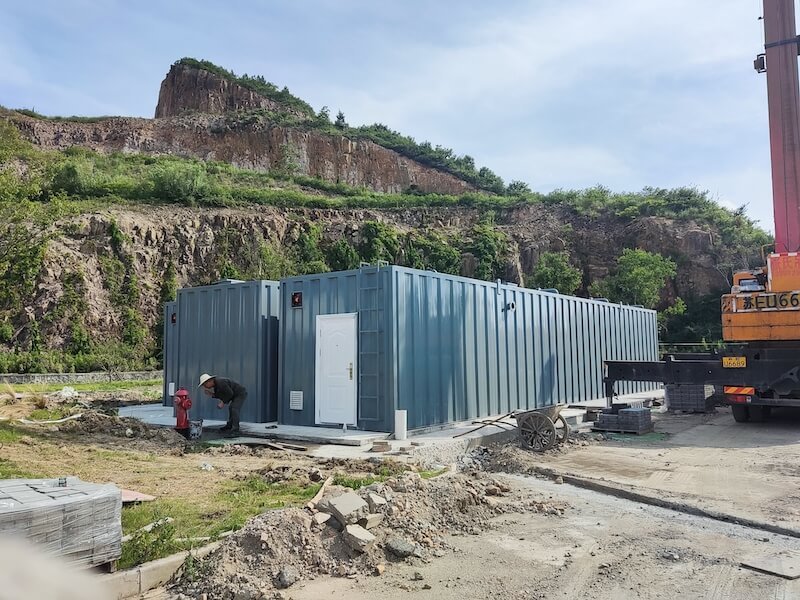Last Updated on August 25, 2022 by Kevin Chen
The sewage in the expressway service area mainly comes from toilet water, flushing wastewater, catering wastewater, cleaning water, etc. Affected by weather, season, time, and some other special conditions, the traffic flow will be very random, leading to low-load operation of the influent water quality.
During holidays, the water volume fluctuates greatly, especially in the toilets and showers, which leads to high concentrations of ammonia, nitrogen, and SS in the sewage in the service area, and the water volume may vary every hour, every day, day and night. The urban sewage pipe network cannot be arranged by geographical location, and the discharge standard must meet the first-class A standard in the “Pollutant Discharge Standard for Urban Sewage Treatment Plants” (GB18918-2002).
The below 2 cases provide an overview of the MBR membrane application for the expressway wastewater treatment process, including how it works and its benefits.
Case 1: Expressway Wastewater Treatment – Xinxiang Service Station
The project mainly deals with toilet water, flushing wastewater, catering wastewater, and cleaning water generated in the service station of Henan Xinxiang expressway. The sewage treatment capacity is 150m3/d, and the treated effluent meets standard A in class I in the discharge standard of pollutants for urban sewage treatment plants (GB18918-2002).
The sewage has high organic matter concentration, large water quality, quantity fluctuation, and strong biodegradability. The main pollutants are suspended solids, hydrocarbons, proteins, animal and vegetable oils, nitrogen and phosphorus compounds, surfactants, microorganisms, and inorganic salts.

MBR Project Overview
| Location | Xinxiang Service Station, Henan Province, China |
| Type of Wastewater | Domestic Wastewater |
| Flow | 150 m³/d |
| Commissioned | Since June. 2019 ( SPERTA MBR Membrane ) |
MBR Process Flow Chart

Influent Condition and Effluent Quality
| Index | Influent Condition | Designed Effluent | Actual Effluent |
| CODCr(mg/L) | ≤450 | ≤50 | 37 |
| BOD5(mg/L) | ≤280 | ≤10 | 7 |
| SS(mg/L) | ≤280 | ≤10 | 2.5 |
| Ammonia Nitrogen(mg/L) | ≤60 | ≤5 | 3 |
| pH | 6~9 | 6~9 | 6~8 |
| TP | ≤8 | ≤0.5 | 0.3 |
| TN | ≤80 | ≤15 | 9 |
Case 2: Expressway Wastewater Treatment – Zhenping Service Station
The raw water of this project is the domestic wastewater and toilet flushing sewage generated in the service station of Zhenping Expressway in Henan Province. The sewage treatment capacity is 100m3/d, and the treated effluent meets the grade A requirement in the discharge standard of pollutants for urban sewage treatment plants (GB18918-2002).
Characteristics of the sewage treated in this project: It will be bound to seriously affect the surrounding environment if there is no effective treatment that the sewage is high in organic substances, bacteria, etc. The raw water is complex with high ammonia nitrogen-containing and mostly in “low load” operation. Still, its volume fluctuates greatly during holidays due to its location at the service station.

MBR Project Overview
| Location | Zhenping Service Station, Henan Province, China |
| Type of Wastewater | Domestic Wastewater |
| Flow | 100 m³/d |
| Commissioned | Since June. 2019 ( SPERTA MBR Membrane ) |
MBR Process Flow Chart

Influent Condition and Effluent Quality
| Index | Influent Condition | Designed Effluent | Actual Effluent |
| CODCr(mg/L) | ≤400 | ≤50 | 37 |
| BOD5(mg/L) | ≤250 | ≤10 | 7 |
| SS(mg/L) | ≤250 | ≤10 | 2.5 |
| Ammonia Nitrogen(mg/L) | ≤50 | ≤5 | 3 |
| pH | 6~9 | 6~9 | 7~9 |
| TP | ≤6 | ≤0.5 | 0.2 |
| TN | ≤60 | ≤15 | 7 |












